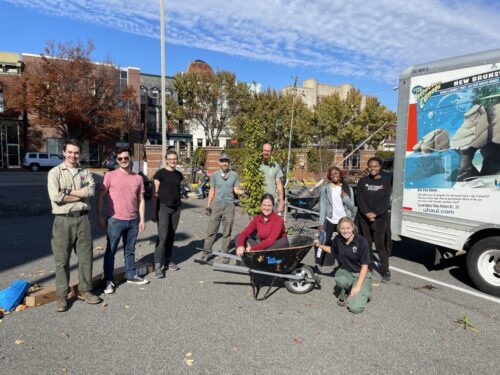Urban Trees “Releave” the Heat
January 28, 2022 3:31 pm

By Eli Podyma, VDOF Community Forester
A large part of my work as a community forester involves collaborating with local non-profit organizations to protect and enhance the urban forest canopy. One of these organizations, Southside Releaf, was recently featured on an episode of Virginia Homegrown, speaking about their mission to build a healthy, equitable, and sustainable environment for all South Richmond residents. Sheri Shannon, co-founder of Southside Releaf, mentioned partnering with the Virginia Department of Forestry’s (VDOF) community foresters during that interview. If you saw the episode, you know that Southside Releaf is working to combat urban heat islands in Richmond through tree plantings and giveaways to homeowners across the city. What you might not know is how the Virginia Department of Forestry factors into this work, so I want to give a brief overview of how we’ve been involved.
To start, let me explain exactly what urban heat islands mean for our cities. Urban heat islands are parts of a city that tend to accumulate and retain more heat than surrounding areas. In Richmond, Science Museum of Virginia studies show that there can be “at least a 16-degree difference between the warmest and coolest parts of the city during an extreme heat event.” Further studies by the Science Museum across multiple cities in the U.S. have shown that redlined neighborhoods – those that were deemed to have “undesirable” occupants in the 1930s and 40s – tend to experience the effects of these urban heat islands at a higher rate than other communities. This may be because redlined neighborhoods tend to have more impervious surfaces like concrete and asphalt, fewer parks and other green spaces, and less tree canopy than other areas of the city.
So where does the Virginia Department of Forestry fit into urban forestry and the fight against these heat islands? If you’re trying to establish a new canopy to provide shade in a built environment, not just any tree will do. VDOF community foresters have experience and technical knowledge to connect local organizations like Southside Releaf with the right trees for their plantings. In addition to technical guidance, community foresters help to disperse grant funding from VDOF to non-profits and municipalities that will pay for trees, plantings, and even help fund forestry jobs in local governments. We’re also great at bringing partners together to complete forestry projects in communities across Virginia.
- Arbor Day seedling giveaway with Capital Trees at Shiplock Park
- Aaron McFarland of TreeLab plants a tree in Richmond’s historic Jackson Ward
Basically, community foresters are here to provide science-based planting and management advice to urban forestry projects, in the same way that Virginia’s rural foresters have been helping manage rural forests since the Department was established in 1914. From time to time, we even get the chance to work on projects that are a little out of the ordinary, like helping Sheri find her grandmother’s employment records from when she was a VDOF tree nursery employee in the 1970’s and 80’s! I guess once forestry is in the family it tends to stick. These intergenerational connections are part of what makes working at an agency like VDOF such an incredible experience, and are at the heart of what community forestry is all about: protecting and enhancing our forested spaces for generations to come.
Tags: Partnerships, Tree Planting, Urban Forestry
Category: Urban and Community Forestry


